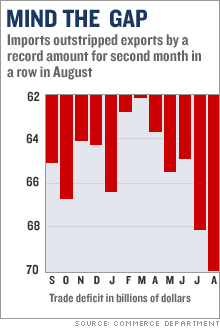|
Trade gap record near $70 billion Jump in imports, record oil prices push deficit to second straight mark in another sign of a growth slowdown. NEW YORK (CNNMoney.com) -- The trade deficit jumped in August to nearly $70 billion, a record for the second straight month, as the nation's appetite for imported goods and costly oil outstripped strong exports, according to government figures released Thursday. U.S. imports topped exports by $69.9 billion in August, up from the previous record of $68 billion set in July, the Commerce Department said.
Economists surveyed by Briefing.com had forecast that the trade gap would narrow to $66.5 billion. The trade gap is an important measure of the nation's economic health. A rising gap dents economic growth because imports can displace production at home, sometimes at the cost of U.S. jobs. A larger trade deficit subtracts from the gross domestic product, the broadest measure of the nation's economic activity, which slowed to an annual growth rate of 2.6 percent in the second quarter from 5.6 percent in the first quarter. With the first two months of the third quarter now both having record trade deficits, that will put even more pressure on that closely watched economic reading. "It is a pretty bad figure," economist David Sloan of 4Cast Ltd. in New York told Reuters. "We now expect to see a pretty weak third-quarter GDP figure, significantly below 2 percent." The gap widened even as exports rose 2.3 percent to a record $122.4 billion in August, just ahead of the export record set in June. But imports climbed even faster, up nearly 2.5 percent to $192.3 billion. Part of the reason for the widening gap was the high price for oil in August. The average price paid for a barrel of imported oil rose to a record $66.12 that month, from the previous record $64.84 set in July. The amount of the deficit from oil rose by $435 million. Oil futures, which generally measure the price of oil about a month ahead of its purchase, have fallen sharply for the last two months, though, raising hopes that the trade picture may improve in coming months. "We are likely to see a retreat on the energy side of the equation. But we'll be at a historically high average," said Jason Schenker, an economist with Wachovia. But Thursday's numbers show that oil prices are not the only factor driving the trade gap higher. U.S. consumers and businesses keep snapping up imports other than oil, with the deficit from other products climbing by $1.5 billion to $27.2 billion. The biggest deficit was with China, as imported Chinese goods outstripped exports by just under $22 billion, up from $19.6 billion in July. The year-to-date trade gap with China now stands at $143.3 billion, up 13.5 percent from a year earlier. University of Maryland Economics professor Peter Morici also argues a wider trade gap eats into what American businesses will spend on research and development. And he says that China's efforts to keep its currency pegged to the dollar rather than allowing markets to take it higher has cost the U.S. economy about 4 million jobs since 2000 by increased U.S. exports from that country. Among the non-petroleum items lifting the trade gap in August were consumer goods, in which imports increased by $678 million; automobiles and auto parts, which saw the imports rise by $522 million; telecommunications equipment, which saw imports grow by $356 million; and computers, computer accessories and semiconductors, which together saw a $287 million increase in imports. Schenker said one encouraging part of the report was that imports of industrial supplies and materials also showed strong growth, suggesting that U.S. manufacturing is staying strong and buying the equipment and raw materials it needs to keep production going, despite signs of a weakening U.S. economy. The National Association of Manufacturers said the report shows the gap in manufactured goods staying relatively level, with August exports up 15 percent from the year-ago figure, while imports rose 12 percent in the same period. The industry group also said August marked the 10th month in a row in which manufactured goods exports rose more rapidly than imports. Still the year-to-date overall trade gap is running 14 percent ahead of last year's record pace. At this pace another record annual trade deficit is likely to be set in 2006, perhaps as soon as November. |
|


